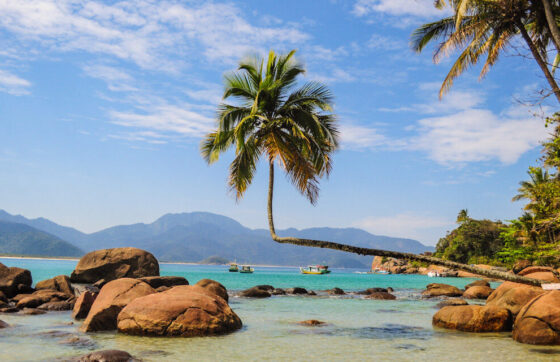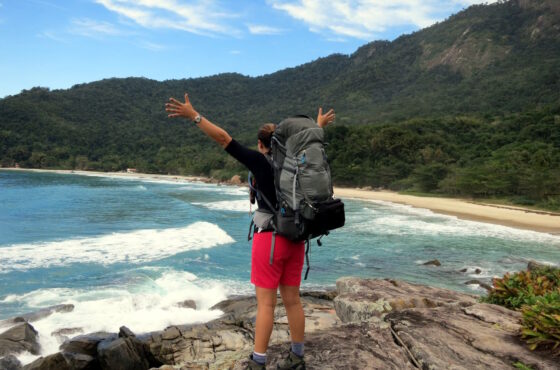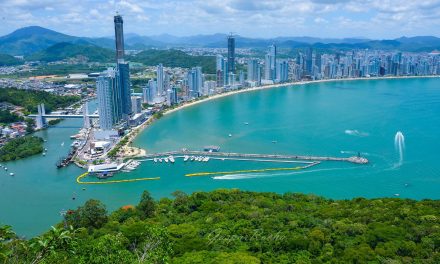By Sandra Lobo | Translation: Andrea Alves
 Along with an unspoiled beauty of natural waterfalls, mountains, and crystal clear waters, the island holds the former Candido Mendes prison, a grim reminder of those prisoners that suffered and die in prison. Those who pass by the former prison, sense the feeling of anguish from being deprived of freedom in such paradise.
Along with an unspoiled beauty of natural waterfalls, mountains, and crystal clear waters, the island holds the former Candido Mendes prison, a grim reminder of those prisoners that suffered and die in prison. Those who pass by the former prison, sense the feeling of anguish from being deprived of freedom in such paradise.
Ilha Grande was discovered in 1502, by the Portuguese navigator Andre Gonçalves. The island has a rich history including the German explorer Hans Staden, whose ship sank in off the coast in 1554. Staden was captured by the Tupinambás Indians and became a prisoner in the Mangaratiba region. Staden was condemned to death in a cannibalism ritual, but managed to escape and return to Europe. Staden published a book about his escape from death and adventures in Ilha Grande.
After this, the “paradise island” even received the visit from Corsairs decided to steal the natural resources of the coast. With abundant vegetation, fruits, sweet water, and rich in “Pau Brasil” (best-quality wood), soon became the ideal refuge of smugglers, pirates and slaves dealers.
In 1863, the Emperor Pedro I (first) decided build a hospital where immigrants arriving from countries hit by the cholera epidemic could be put in quarantine. Brazil had opened its doors to immigration as part of a three-point plan hatched by the Emperor: as a substitute for manpower lost with the prohibition of the slave trade, to strengthen the country’s frontiers with small landowning settlements, and, principally, to “whiten” the Brazilian population. Ships sailed from Germany, Japan and Italy loaded with emigrants in search of a better life.
At this time, born the “Lazareto”, planned as a hospital for men and women filled with dreams and ideals, and ended its days as a penitentiary for the desperate. It became the Penal Institute Candido Mendes in 1941. “Home” to the Comando Vermelho (Red Command), one of the biggest crime organizations still in existence today in the country, the Cândido Mendes was imploded in 1994. With the collapse of the prison another page is turned, and there is a different side of Ilha Grande to be seen. A paradise full of extremely beautiful sights which is one of the reasons so many adventurers become enchanted with the island. Nowadays, Ilha Grande’s major tourist are Italian, German, Swiss, French and Canadians who come in pursuit of tranquility and nature.
Where is IIha Grande and how do you get there?
It is located in the State of Rio de Janeiro, in the city of Angra dos Reis. Ilha Grande is an area covered by the Atlantic forest and has 106 beaches. To get there and enjoy the beauties of this paradise, the tourist must go to the city of Mangaratiba (Lapa’s wharf) or to the Angra dos Reis port. There are several options to take a boat or ferry to the island. Remember vehicles are not allowed on the island, chose a private parking lot for a flat fee.
Best beaches
With more than 100 beaches to choose from, the visitor will be able to find a beach suitable for their needs. Ilha Grande has small beaches, but also beaches with 3 Km of extension such as Lopes Mendes, whose access is made by trail or boat. For those who look for a little more of infra-structure, “Bed & Breakfast” hotels in the Vila do Abraão beach is recommend. Also 90% of the lodges are ideally located close to yatches and tours. For the scuba lover, Abraão beach is where you can rent diving equipment.
Castelhanos beach, has one of the oldest lighthouses in the Brazilian coast; built in the XIX century, it conserves the original French project on crystal lenses. Caxadaço, a smaller beach, is considered as one of the best in the entire island. According to many people, the Praia do Aventureiro beach, is also beautiful with amazing sights of fine and silver sand. Don’t skip the visit to Gruta do Acaiá (Acaiá Cave), where one can observe the phenomenon of fluorescent water. Other beaches no to miss are Saco do Céu (Sky bag), Estrelas (Stars), or Lagoa Azul (Blue Lagoon).
Vila Dois Rios (Two Rivers Village) The claim to fame of this area are the ruins of Cândido Mendes which have lead to the preservation of the island. Nowadays few people live in Vila Dois Rios and those that do serve meals to visitors.
Treasure Hunters and Explorers
The Ilha Grande bay has one of the greatest concentrations of sunken ships of the world. Six ships are registered many derived from battles between the Corsairs, pirates and the empire. The best places for diving are Ponta dos Castelhanos, Jorge Grego, Ilha dos Meros, and Naufrágios. Remember that fishing is prohibited 1 km around the island.
Eco-hiking is an excellent option for those who want to observe the native fauna and flora. There are millions of hiking trails; many connecting one beach to the other. The best seasons for hiking is May, July, October, and November when the temperatures are milder and there is little rain. The main points for departure are Abraão and Araçatiba.
Recommended beaches for surfing are Lopes Mendes, Santo Antonio, Aventureiro and Demo. Camping is allowed in designated areas only, or possibly with a permit. Marine cruises, are the most sought-after activities by the tourists.
The best routes are: Palmas/Lopes Mendes, Lagoa Azul/Freguesia, Lagoa Verde, Gruta do Acaiá and Saco do Céu. The majority of cruises leave from Abraão, but there are options for cruises in Araçatiba, Bananal and Sítio Forte, and prices vary from US$ 5 to 15. In Ilha Grande, the tourist needs a lot of vigor to know the island and everything it has to offer. Or simply relax under the shade of what History preserved.
* For airline tickets from the U.S to Brazil or Latin America, customized travel packages, hotels and cruises, please visit our travel agent page or contact Magali Da Silva by Phone or Whatsapp: 1 (323) 428-1963. We are based in Los Angeles, California and have been established for over 25 years.
















